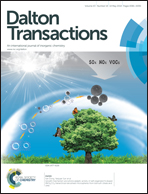An organic–inorganic hybrid semiconductor material based on Lindqvist polyoxomolybdate and a tetra-nuclear copper complex containing two different ligands†
Abstract
A 3D organic–inorganic hybrid compound based on the Lindqvist-type polyoxometalate, [{Cu(phen)}3{Cu(μ2-ox)3}{Mo6O19}] (1) (phen = 1,10-phenanthroline, ox = oxalate), has been synthesized under hydrothermal conditions and structurally characterized by elemental analysis, IR, TG, PXRD, XPS, UV-vis, and single-crystal X-ray diffraction. In compound 1, three C2O42− ligands bridge one Cu atom and three Cu(phen) fragments to form a tetra-nuclear copper(II) coordination complex [{Cu(phen)}3{Cu(μ2-ox)3}]2+ unit. The six-node [Mo6O19]2− clusters are interweaved by the 6-connected tetranuclear copper(II) complex units into an intricate 3D network structure, exhibiting a 412·63-nbo (sodium chloride-type) topology. Compound 1 exhibits the highest connectivity of Lindqvist-type POM hybrid materials. The electrochemical behavior of 1-CPE has been investigated in detail. Furthermore, a diffuse reflectivity spectrum of 1 reveals the presence of an optical band gap and the nature of semiconductivity with a large energy gap. A magnetic susceptibility study reveals predominant antiferromagnetic interactions between the CuII bridge units.


 Please wait while we load your content...
Please wait while we load your content...